How Have Tanks Affected People’s Careers?
Gareth Evans MBE and Jim Hughes interviewed by George Beech
My interview consisted of meeting former Royal Air Force Squadron Leader Gareth Evans MBE and Royal Armoured Corps Commander Jim Hughes on March 14, 2023. During this two-hour interview, both interviewees expressed in detail their experiences with armoured vehicles and their time in combat. Jim, who was a commander of a light reconnaissance squadron, spent most of his military career either as an instructor in manoeuvres or on the battlefield itself in and around tanks, completing tours in Iraq, Kuwait, Germany and Saudi Arabia. Jim spent time with British tanks such as the fearsome Chieftain, Spartan and
Scorpion tanks. When discussing the grandeur of larger tanks such as the Chieftain, Jim described the first real life combat in the Gulf War he experienced as surprising with the quote, “you could feel the ground shaking and everything is a bit real now.” Lawrence Freedman aligns with Jim’s expertise by quoting that the ground assault during the Gulf War in regard to military firepower for the coalition forces was its “decisive, overwhelming character.”
Jim and Gareth both served in the British Army during the 1980s and 90s with Gareth starting his early career in a flying squadron of the British Army. As Gareth rose up after years in the Army, he joined the Ministry of Defence in London where he reached director level in the hierarchy. He focused during his
time in the MoD on logistics for tank squadrons over in Iraq during the Gulf War. During the interview, Gareth joked that he could have supplied the equipment Jim used during his time on tour in his tanks under his command. Before retiring in 1999, Gareth received an MBE (pictured right) to commemorate his service for the British Army and his longstanding career.
QUICKFIRE QUESTION! WHERE IS THE MOD BASED IN THE UK?
(answers at bottom of page.)
Whilst Gareth provided logistics for the tanks used in warfare, Jim was in the thick of it during his time in the Gulf War with active years of service during the most heightened moments of the campaign. He experiences includes seeing the Berm that was created by the Americans or ‘Big Red One’ as he referred to them as. He also experienced the infamous oil fires in Kuwait in the last few weeks of the war and also travelled down the ‘Highway of Death.’ As John G. Heidenrich quoted that a , “large number of Iraqi’s were killed,” with a decent proportion of these being committed on the Highway of Death. Huge amounts of destruction befell Kuwait and Iraq with American tank and air divisions dropping more tons of explosives in the Gulf War than Vietnam and WWII combined, says William Eckhardt. When describing his feelings during this tumultuous time, Jim describes his levels of fear being relatively low. He quoted that the men with him were highly trained and well-disciplined which meant each man knew his role and performed it well.
Jim had a central role in a tank centred combat during Operation Desert Storm and looks back on his time fondly. He enjoyed his time around the Armoured Division and due to this, Jim returned for a second tour in Iraq in the mid-90s with his tank unit. He sees armour as a very important and meaningful part of his life, even to this day where he spoke with me for two hours just about his experiences over the course of a few months. Gareth also believed that tanks impacted his career and later life with his continued passion throughout his life. He noted having a keen interest in tanks as a boy and this has continued even after retirement with many models and memorabilia around his house all centred around British Armour.
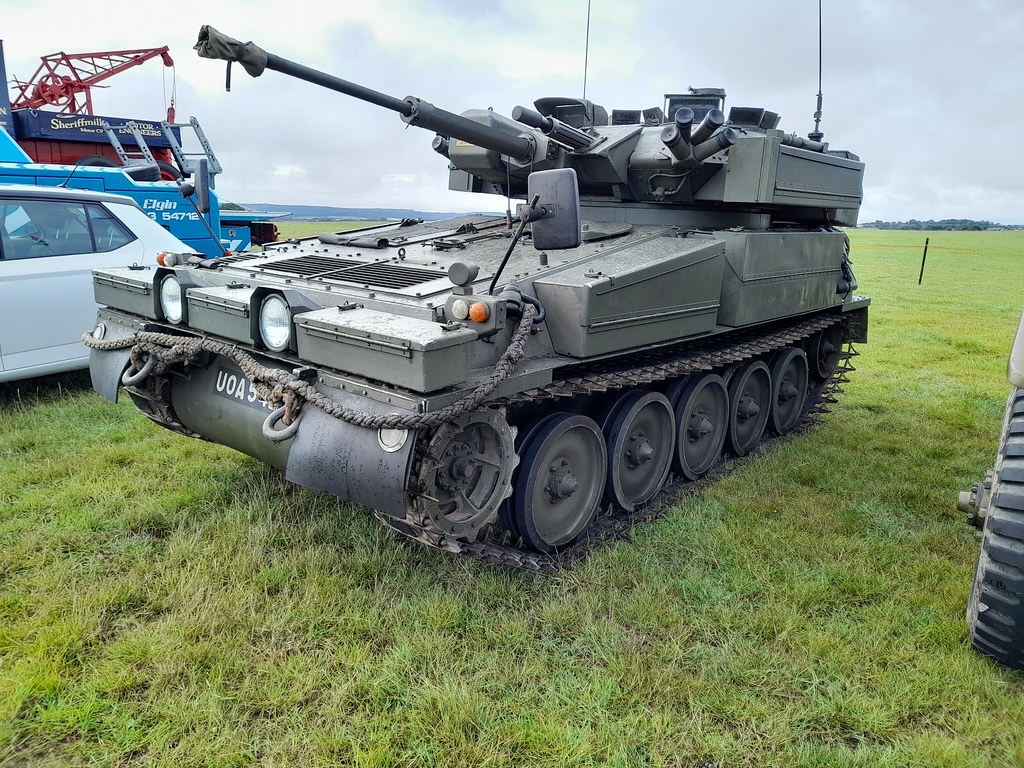
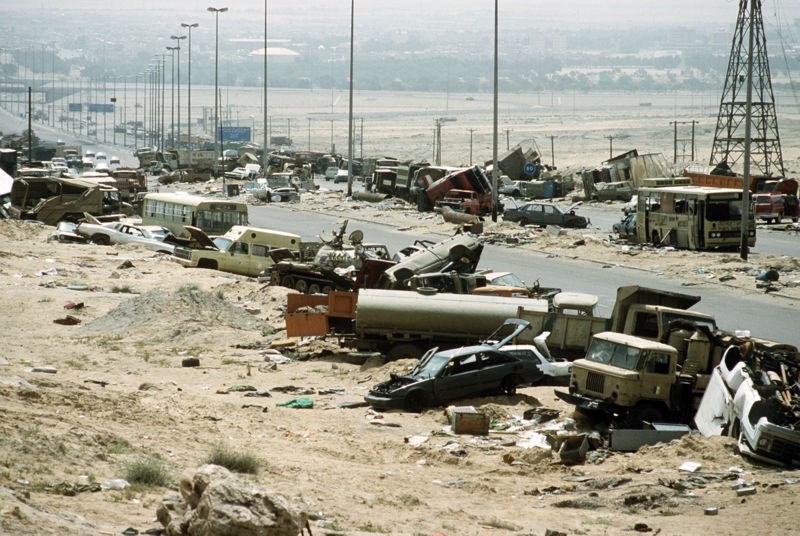
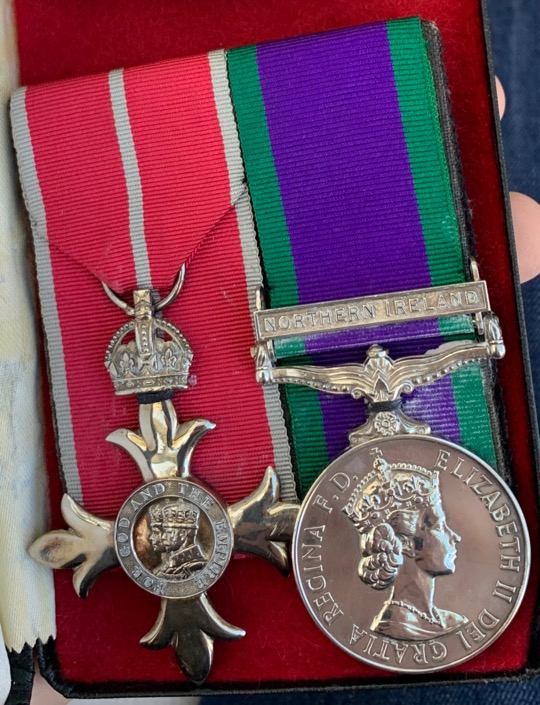
alongside a medal attained through service in Northern Ireland.
David Little interviewed by Ben Turner
David Little, who had a varied career in the armoured regiment, the 14th/20th King’s Hussars served with several different tanks. David mainly spoke of his time with the Chieftain, Britain’s and in fact NATO’s first main battle tank (The Tank Museum). He travelled around the world prior to enlisting in the army but was influenced to join the military from witnessing events of the Suez crisis, after seeing the professionality of the army. He saw the 14th/20th Kings Hussars based at Tidworth Barracks who were preparing to be deployed in Northern Ireland. After getting back from working as a civilian in Libya, David decided to join the army.
Connections to Bovington:
David also came to Bovington both as a civilian prior to joining the army, but also for communications training, at the various schools in Bovington. David has since been involved with various events at The Tank Museum, such as events celebrating the 80th anniversary of the Royal Armoured Corps.
David detailed his time spent being deployed in west Germany and west Berlin, where he participated in several regimental duties, such as sporting competitions and ultimately a lot of training on the ranges. Whilst in Germany, David was part of a chieftain squadron, and spoke of the annual Royal Armoured Corps gunnery camps. He was a squadron signals SNCO, and a troop leader. David’s last gunnery camp was highly successful, where he used so little ammunition, due to many of the shots being on target, averaging targets either on the first or second shot. “The target was presented and reported destroyed within 7 seconds.” Afterwards, David was promoted, and severed in West Berlin, where it was “PR in the summer and training in the Winter.” This meant David was involved in events such as the Queen’s birthday parade, the Berlin military tattoo, military music festival, and the military polo tournament, due to serving in a cavalry regiment. Later in his career, David served with the Joint Arms Control Implementation Group, which involved arms and weapons inspecting in the last years of the Cold War.
David’s career represents how tanks can ultimately influence someone’s career, as one of the motivations for David joining the military, was seeing tanks being utilised in many different capacities. Furthermore, some of David’s proudest moments of his career, such as his success in his last gunnery camp, involved tanks. Tanks have greatly affected David’s career, and thanks to the tank, David had a varied career having various roles in Britain’s military policy during the Cold War.
To see the differences between the day-to-day life of a solider involved with tanks during the Cold War to
that of a modern-day solider see below to see how life in an armoured regiment has changed since the first Gulf War.
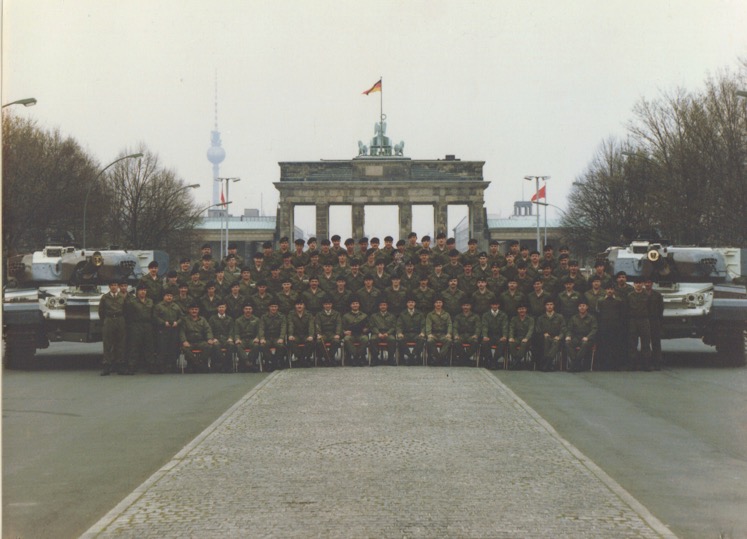
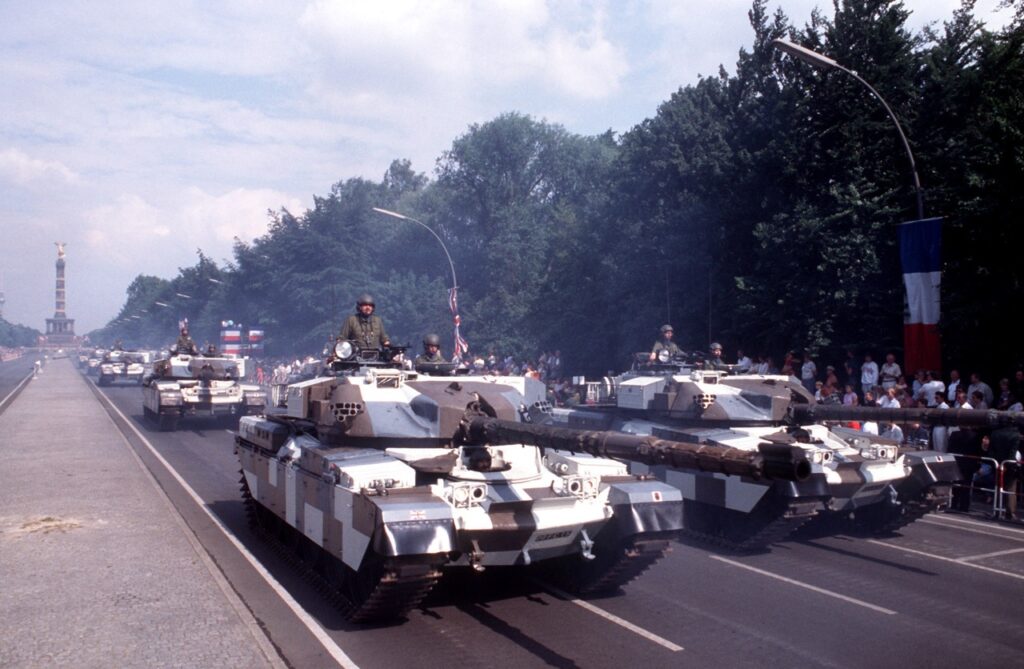
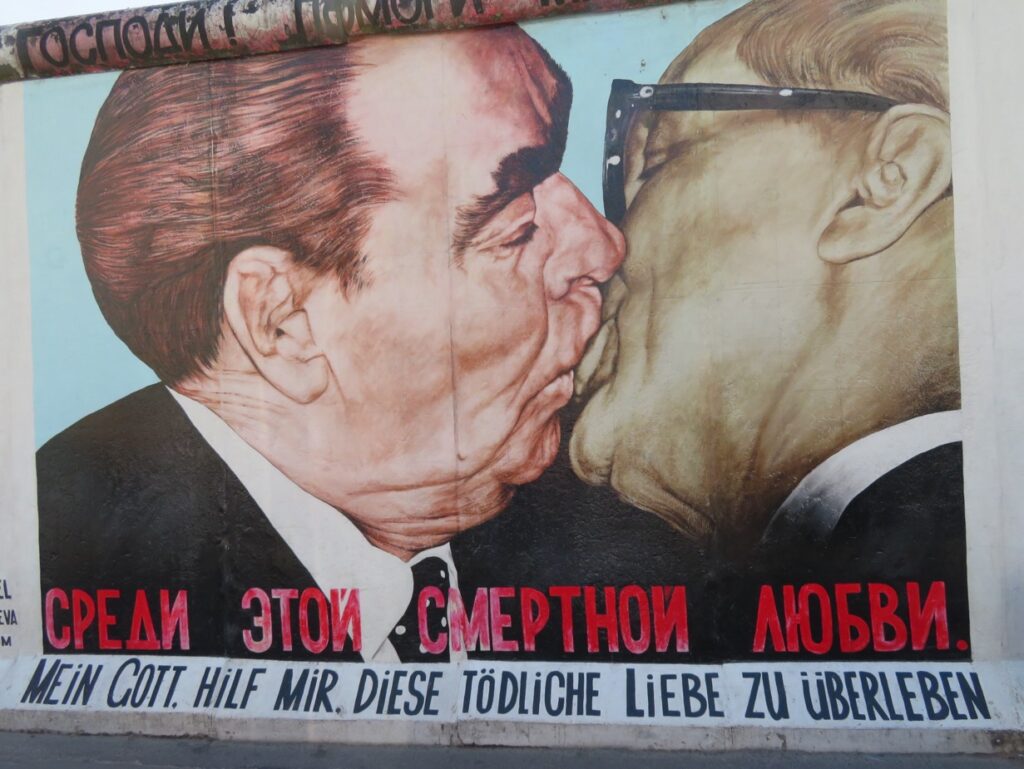
A famous piece of graffiti decorating the Berlin Wall, depicting the “socialist fraternal kiss” of Soviet premier Leonid Brezhnev and leader of East Germany, Erich Honecker. A presence in Western Germany was highly important for the Western powers (Britain, France, and America). Cold War historian, John Lewis Gaddis details the importance of a presence in Germany throughout his book The Cold War. David’s interview and time in Germany adds extra insight into what soldiers did whilst stationed in west Germany.
Rajesh Kataria interviewed by Natasha Goldsworthy
What was said in the interview?
Rajesh Kataria grew up in a working-class family in Leicester with six other siblings. His education included a civil engineering degree at Nottingham Trent University which allowed him to join the Royal corporate in 1992. Raj recalls his love for tanks began with the show Thunderbirds, where crime was fought with superhero’s using machinery including tanks. Historian Handlin explains that popular culture of technology allowed the public to stop following traditional labour jobs. This is exactly what happened with the interviewee who chose to join the military which made him the first in the family. Most of the interview surrounded his engineering degree which overlapped into his profession which helped him gain experience physically rather than through essays. Rajesh argues that people who have previous qualifications can learn new styles of subjects. Any degree can work alongside the military if wanting to change original career. This is important for the younger generation who may worry about their education. Do not put too much pressure on yourself as there are always different routes to take.
Furthermore, the interviewee begins to wrap up the section about training, which leads him to explain how each soldier had to learn three to six modules. These modules could consist of one-to-one fighting, explosives, and fitness. Kataria exclaimed that demolishing were the best module to complete. Within his
regiment they had to travel globally creating bridges via tanks. This will be explained further in the next section.
How did tanks affect the interviewee?
Instead of Rajesh Kataria using tanks for military purposes he used the machinery to help build bridges around the globe. These tanks include the M60 Armoured vehicle Launch which helped lay the foundation of bridges. Other tanks were used to carry tools and products in ditches which would save a large amount of time. The positives of also using tanks meant that builders would not get hurt during the process of carrying and loading the resources. As the interviewee had to help build bridges globally, I asked which was the best tank he used. This is because where the interviewee was taken, he would have to use the locally sourced tanks which varied depending on the country. His response was that British tanks were the best even if he is biased!
Retrospectively, Kataria is correct in the sense that US and NATO tanks weigh over sixty tons which cause the problem of not being able to manoeuvre. The heavier the tank the more difficulty of also being able to get out of deeper ditches. While Germany has better tanks as it can overcome water and obstacles easily
compared to the US tanks. This makes it difficult to compare the different tanks and which one is the best to build bridges. This challenge can be given to you, to view the different tanks from the United Kingdom and Germany and choose which one you believe is better. Try not to be biased!
Shaun Hadley interviewed by Abbie Davies
Shaun Hadley is an Armoured Cavalry Crewman with the Royal Dragoon Guards. He started his driver training Bovington on the CVRT Scimitar where he qualified to drive tracked vehicles. After getting to his regiment Shaun then trained as a gunner on the Jackal 2 before his deployment to Poland as part of Operation Cabrit as part of the NATO’s Enhanced Forward Presence. Deploying during winter he
had the opportunity to complete a cold weather operators’ course and water crossings as part of the American battlegroup as well as being acquainted with the American driven Stryker’s, where they worked specifically with the National Guard. After his deployment his regiment moved onto Warrior’s an infantry command vehicle, Shaun became a driver for this vehicle.

Cpl Ian Holding. ‘A Jackal Armoured Vehicle is put through its paces in the desert at Camp Bastion, Afghanistan’
[Digital Photograph]. 31/03/2008.
Defence Imagery. Accessed 12/05/2023.
Shaun grew up with the military as his father was an Aircraft Engineer in the Royal Air Force working mainly on Helicopters. As a teenager he joined the Royal Air Force Air Cadets where he found he really enjoyed fieldcraft, he tried to attend as many camps as possible which included many to Sennybridge. His liking of tanks came from watching history documentaries which often included topics on World War 2, weaponry, tanks, and planes. Joining the Army came with a myriad of injuries and challenges which led to delay on his joining date. This does not include the delays which Covid-19 came with, Shaun went through training
during this time which meant that there were aspects which had been removed such as adventure training and educational visits to Belgium and The Tank Museum. Focusing on his career to come Hadley suggests he would like to complete his B3 gunners’ course to be crew complete as well as explore the possibility of becoming a Driving Maintenance Instructor as well as Armoured Cavalry Commanders course.
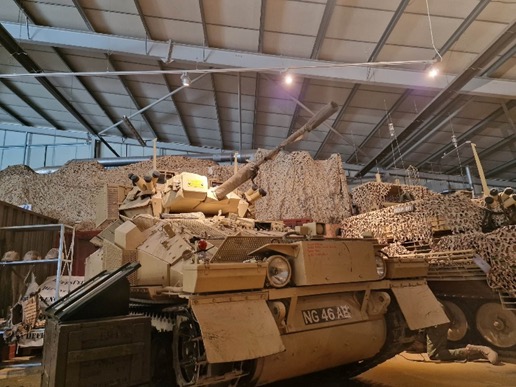
Photograph]. 30/03/2023. Accessed 12/05/2023.

Tank Fact Cards
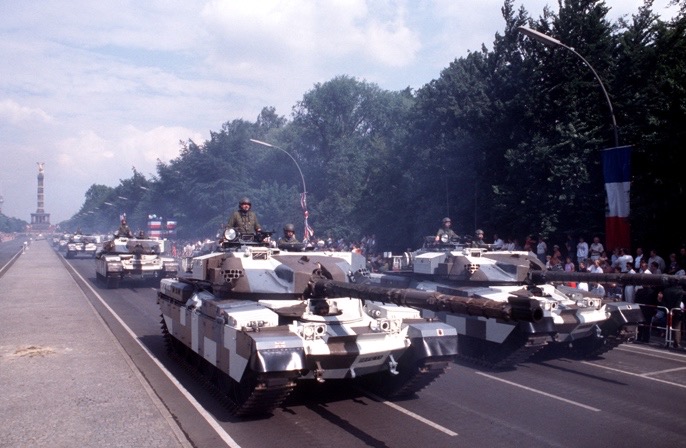
FV201 Chieftain Mark 11c Main Battle Tank
No. produced: 4400.
Main Weapon: 1 x 120mm gun
Weight: 55 tons
Speed: 48 kph
Crew: 4
Armour: 388m
Britain’s first main battle tank and used by David’s regiment, 14th/20th King’s Hussars as seen here in Berlin in 1989. This tank can be found in the Cold War exhibit of The Tank Museum. Introduced in the 1960s, it saw
various action in conflicts in the Middle East, being used by Iran during the Iran-Iraq War (1980-88). Chieftains were later used by Kuwait in 1990, during its war with Iraq. Chieftains, as pictured above were
stationed in West Germany and West Berlin, participating in various ceremonial duties and parades and various gunnery camps, as referred to in David Little’s interview. Below is a link to The Tank Museum’s informative video of the specifications of the Chieftain. A Chieftain can be seen in the Cold War Exhibit of the Museum.
https://www.youtube.com/watch?v=D3OF9IvtHLk
FV1O1 Scorpion
No. produced: 3000.
Main Weapon: 1x 90mm gun
Weight: 8 tons approx.
Crew: 4
Speed: 72.5 kph
A light reconnaissance tank, which was introduced in 1972 was in service in the British Army for over 20 years. It was retired in 1994 from the British military but is still in service with other countries to this day. Scorpions saw service in the Falkland War in 1982 supporting infantry regiments, and later in the Gulf War in 1991. Before being retired they were also used in Bosnia following the Gulf War during the wars in the Balkans. To see an in-depth video on the Scorpion’s specifications, see this informative YouTube Video created by The Tank Museum.
Tank Chats #163 | Scorpion & Sabre | The Tank Museum – YouTube
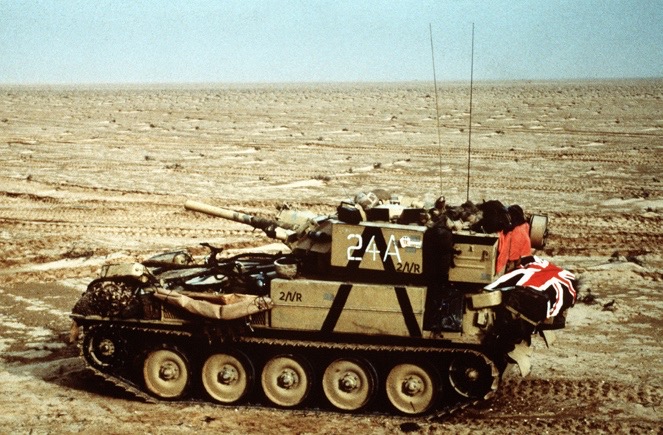
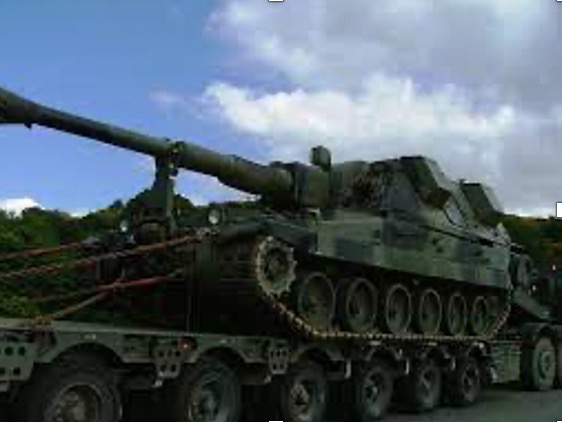
As-90
Speed: 34mph
Operational range: 370kmh
Gun barrel: 39 calibre
The AS-90 is the favourite tank of interviewee- Rajesh Kataria. This resulted in him watching videos on YouTube of the British machinery in operation. The tank entered service in 1992 and was manufactured in Cumbria before making a whooping one hundred and seventy-nine for the British army. The defence minister approved the design of the AS-90 which resulted in a three hundred-million-dollar program in 1995. This allowed the upgrade of one hundred- and fifty-five millimetre howitzer which enabled better range and accuracy. The typical tank can hold four to five average sized males which conclude of driver, layer, loader and commander. The tank was first used in 2003 during the Iraq freedom operation which led to issues regarding the sand terrain. This meant the tank had to be remodelled to provide easy usage in arduous desert environments. Switch to current affairs the British government has donated the AS-90 to the armed forces of Ukraine following the incident with Russia. Three-week training programmes have been in place for Ukrainian soldiers to fight in the AS-90.
FV103 Spartan Armoured Personnel Carrier
No. produced: 967
Main Weapon: 1 x 7.62mm Gun
Speed: 96 kph
Crew: 3 plus 4 passengers
As an extension to the FV101 Scorpion, these vehicles were used in active service during the Gulf War to transport specialist teams across Iraq and Kuwait. These had been in service in the British Army since 1978 and in 2014, the British Ministry of Defence ordered a total of 59 PMRS armoured personnel carriers as a replacement for the Spartans. Some Spartans are still being used in current conflict as some were sent to Ukraine to aid the war effort. Some advantages of the Spartan include the speed and manoeuvrability with a top speed of 60mph. the range on one tank of fuel extended to nearly 500 km which gave the Spartan reliability.
https://www.youtube.com/watch?v=D3OF9IvtHLk
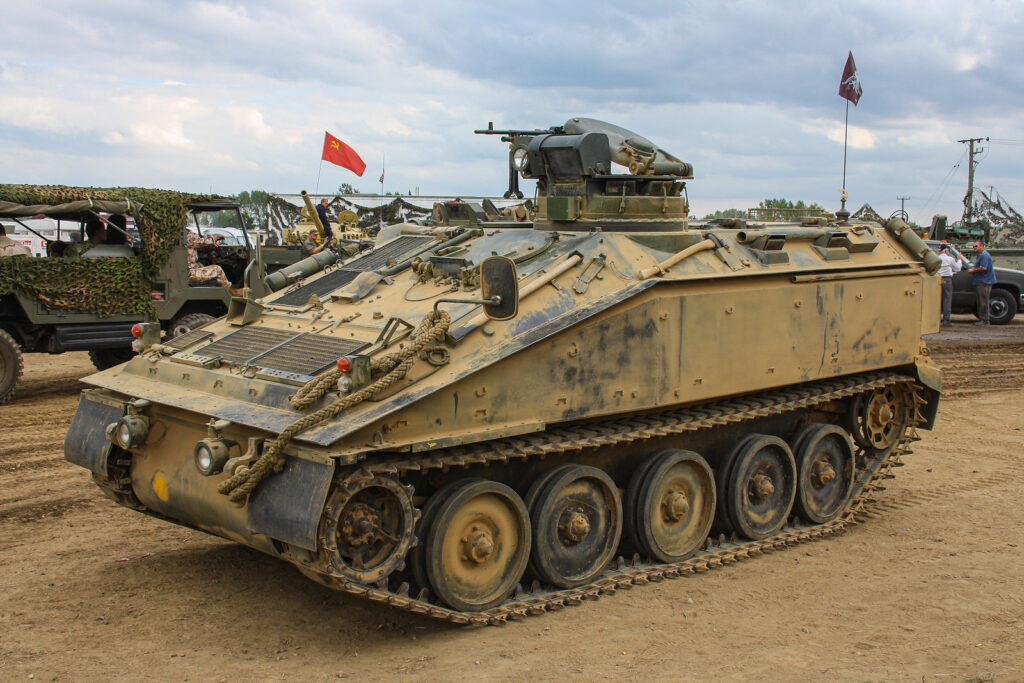

Jackal 2
No. Produced: 431
Main Weapon: GPMG
Weight: 6,650 kg
Speed: 50 MPH
Crew: 3
The Jackal is a high mobility weapons platform, which allows for quick movement across varying terrains. It was designed to protect against IED’s and attacks. This was specifically used in Afghanistan as part of Operation Herrick which is where the Jackal made its debut. Shaun Hadley used this vehicle while deployed as part of Operation Cabrit and their Enhanced Forward Presence in Poland. A Jackal 1 can be found in the Battlegroup Afghanistan: Helmand Province 2011 exhibition.
Photo: Cpl Ian Holding. ‘A Jackal Armoured Vehicle is put through its paces in the desert at Camp Bastion, Afghanistan’
FV4030 Challenger 1 Main Battle Tank
No. produced: 420
Main Weapon: 1 x 120mm Gun
Speed: 56 kph
Crew: 4
Weight: 14 Tonnes
The Challenger 1 battle tank was an advanced powerhouse of a tank that served as a replacement for the Chieftan Main Battle Tank. These tanks started service in 1983 and became the face of the British Armoured Division until the Challenger 2 was introduced in 1989. During the Gulf War, the Challenger recorded the furthest ever confirmed kill on an Iraqi Tank over 5000 meters away. This tank was equipped with a mounted main gun and two machine guns with over 4000 rounds of ammunition. The engine of this tank was a Rolls-Royce Condor turbocharged diesel engine, developing over 1 200 horsepower and could reach speeds of up to 56kph
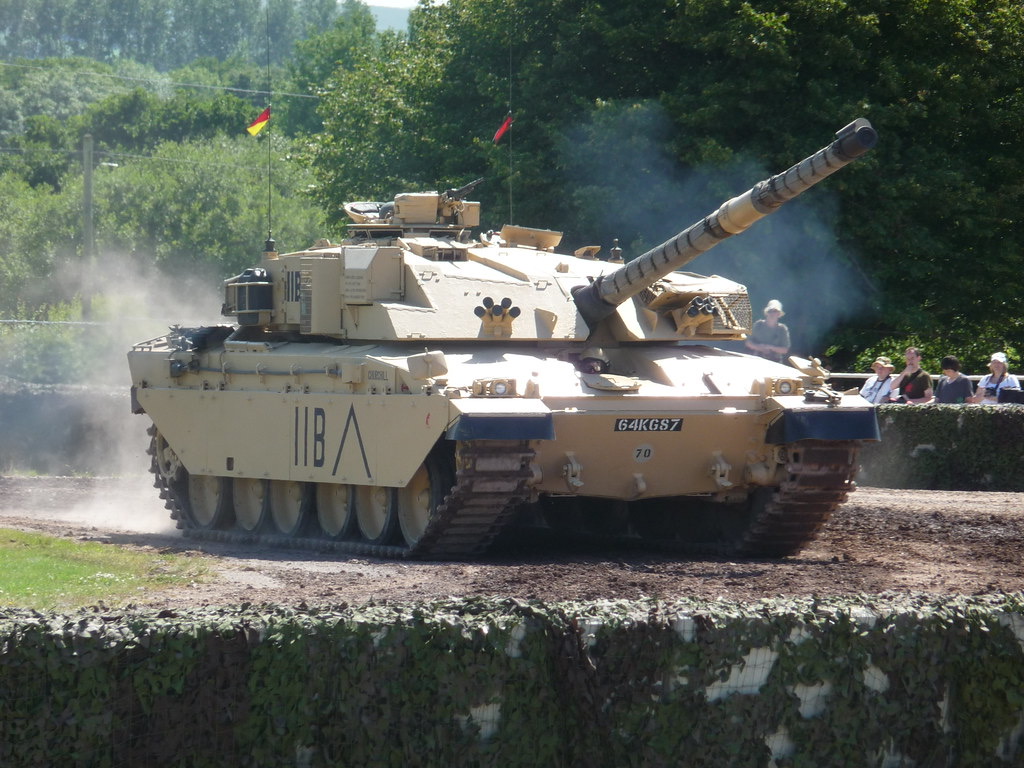
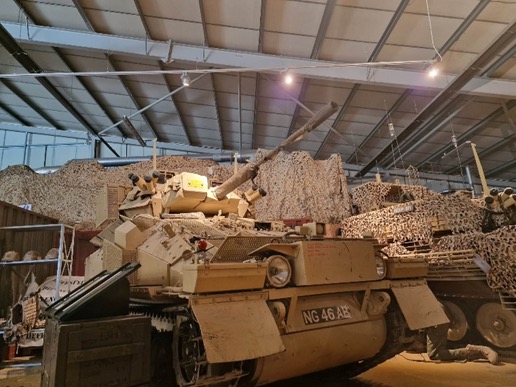
CVRT Scimitar
No. Produced: Over 600
Weapon: 30mm L21 Rarden Cannon
Weight: 7.8 tonnes
Speed: 50 MPH
Crew: 3
The Scimitar is a small sized armoured vehicle which allows it to move over difficult terrain quickly. It was used by reconnaissance regiments in the Royal Armoured Corps. Shaun Hadley used this vehicle to train on while in his Phase 2 element of training at Bovington. Since entering service in 1971 they have been used from the Falklands War up until the War in Afghanistan. It is very similar to the FV101 Scorpion however that vehicles main weapon is a 76mm gun instead of a 30mm L21 Rarden Cannon. The CVRT Scimitar can be found in the Battlegroup Afghanistan: Helmand Province 2011
exhibition.
Photo: Shaun Hadley. ‘CVRT Scimitar 2’
Warrior
No. Produced: 1,043
Main Weapon: 30mm Rarden cannon
Weight: 25.4 tonnes
Speed: 46 MPH
Crew: 3+ 7
The Warrior is an infantry command vehicle which can accommodate an extra 7 soldiers on the 3 crew: a driver,
commander, and gunner. Shaun Hadley is a Driver for a warrior within the Royal Dragoon Guards. The vehicle is mainly used for mechanised infantry but has a secondary role as an armoured reconnaissance vehicle. First used in the Gulf war this vehicle is still used at present in Armoured Cavalry regiments. A Warrior can be found in the Battlegroup Afghanistan: Helmand Province 2011 exhibition.
Photo: PO Terry Seward. ‘British Army Warrior Infantry Fighting Vehicles’

Images and Interviews
Marshall, Sean. “My, God Help Me to Survive This Deadly Love- famous painting of Leonid Brezhnev and Ercih Honecker, by graffiti artist Dimitri Vrubel.” [Colour photograph]. 7 May 2018. Flickr. Accessed 11 May 2023. https://www.flickr.com/photos/7119320@N05/43390077232 .
Paust, Imke. “British Cheiftain Tanks.” [Colour photograph]. 18th June 1989. US Department of Defence via Wikimedia. Accessed 10 May 2023.
https://en.wikipedia.org/wiki/14th/20th_King%27s_Hussars#/media/File:British_Chieftain_tanks.JPEG .
“Scorpion Reconnaissance Vehicle of the 7th Brigade Royal Scots 1st (United Kingdom) Armoured Division, advances into Kuwait from Southern Iraq during Operation Desert Storm.” [Colour photograph]. 28 February 1991. Picryl/ National Archives Catalogue. Accessed 11 May 2023. https://picryl.com/media/a-scorpionreconnaissance-vehicle-of-the-7th-brigade-royal-scots-1st-united-f6db99 .
Wiles, P.C. “C Squadron 14th /20th Kings Hussars, West Berlin 1989.” [Colour photograph]. 1989. Panoramio (Internet Archive/Wikimedia). Accessed 11 May 2023. https://web.archive.org/web/20161013010339/http://www.panoramio.com/photo/16688238 .
Little, David. “Tanks For the Memories Oral History Interview.” By Benjamin Turner. 14 March 2023.
Rajesh Kataria. ‘The Tank Museum.’ Clean feed. Natasha Goldsworthy. Date of interview: 3 March 2023.
Gareth Evans and Jim Hughes. ‘Tanks For The Memories Oral History Interview.’ George Beech. Date of Interview: 14th March 2023.
Tormentor4455. “AS-90” [coloured photograph] 2006. In Wikimedia commons. Accessed 13 May 2023.
Cpl Ian Holding. ‘A Jackal Armoured Vehicle is put through its paces in the desert at Camp Bastion, Afghanistan’ [Digital Photograph]. 31/03/2008. Defence Imagery. Accessed 12/05/2023. https://commons.wikimedia.org/wiki/File:A_Jackal_Armoured_Vehicle_is_put_throu
gh_it%27s_paces_in_the_desert_at_Camp_Bastion,_Afghanistan_MOD_45148137.jpg.
PO Terry Seward. ‘British Army Warrior Infantry Fighting Vehicles’ [Digital Photograph]. 09/10/2012. Defence Imagery. Accessed 12/05/2023.
https://commons.wikimedia.org/wiki/File:British_Army_Warrior_Infantry_Fighting_Vehicles_MOD_45154626.jpg.
Shaun Hadley. ‘CVRT Scimitar 2’ [Digital Photograph]. 30/03/2023. Accessed 12/05/2023. Shaun Hadley. ‘Oral History Interview Shaun Hadley’. Abbie Davies. Date of Interview 12th March 2023.
Q, Simon. British Challenger 1. June 27, 2009. Bovington The Tank Museum, Bovington. British Challenger 1 | Simon Q | Flickr
270862. FV103 Spartan. July 2, 2021. War and Peace Show 2010. FV103 Spartan | War and Peace Show 2010 | 270862 | Flickr
Graham Robertson. Alvis FV101 Scorpion. September 18, 2022. Alvis FV101 Scorpion | Graham Robertson | Flickr
Samer. Highway of Death “Kuwait Basra” 26 February 1991.” August 18, Highway of Death “Kuwait Basra” 26 February 1991 | The Highw… | Flickr
George Beech. Gareth Evans MBE. March 14, 2023. Shiplake.
Further Reading
Gareth Evans MBE and Jim Hughes
Freedman, Lawrence, and Efraim Karsh. “How Kuwait Was Won: Strategy in the Gulf War.” International Security 16, no. 2 (1991): 5–41.
Heidenrich, John G. “The Gulf War: How Many Iraqis Died?” Foreign Policy, no. 90 (1993): 108–25.
David Little
“Active Edge: The Army, Germany and the Cold War.” National Army Museum. Accessed 10 May 2O23. https://www.nam.ac.uk/explore/active-edge-army-germanyduring-cold-war.
“Chieftain.” The Tank Museum. Accessed 10 May 2023. https://tankmuseum.org/tank-nuts/tank-collection/chieftain .
“Berlin Wall Milestone: Down as long as it was Up.” Brooklyn Street Art. Last Modified 12 February 2018. Accessed 12 May 2023.
https://www.brooklynstreetart.com/2018/02/12/berlin-wall-milestone-down-as-longas-it-was-up/ .
Gaddis, John Lewis. The Cold War. London and New York, 2005.
Guttman, Jon. “FV101 Scorpion: Keeping the Light Tank Relevant.” Historynet. Last Modified 25 February 2015. Accessed 12 May 2023.
https://www.historynet.com/fv101-scorpion-keeping-the-light-tank-relevant/?f .
“Scorpion.” Way back Machine, the Internet Archive. Accessed 10 May 2023. https://web.archive.org/web/20080221171530/https:/www.janes.com/defence/land_
forces/supplement/lav/lav_scorpion.shtml .
“The Chieftain Main Battle Tank.” History of the 14th/20th Kings Hussars. Accessed 10
May 2023. https://1420kh.co.uk/chieftain-tank/ .
The Tank Museum. “Tank Chats #163, Scorpion and Sabre.” YouTube. 9 September 2022. Accessed 11 May 2023. Tank Chats #163 | Scorpion & Sabre | The Tank Museum – YouTube
Rajesh Kataria
Alia Shoaib. “Germany to send Ukraine 16 bridge-laying tanks, adding to its arsenal of Western weapons, as it wages as a new offence against the Russian invasion.” Insider. Published June 2023. Accessed
13 May 2023. https://www.businessinsider.com/germany-ukraine-16-biber-tanks-defense-ministry-2022-7?r=US&IR=T.
David Axe. “What can stop NATO Tanks in Europe? Weak old bridges.” National Interest. Published 19 November 2021. Accessed 13 May 2023. https://nationalinterest.org/blog/reboot/what-can-stop-natotanks-europe-weak-older-bridges-196505.
Axe. “What can stop NATO Tanks in Europe? Weak old bridges.”
“AS-90 Braveheart 155mm self-propelled Howitzer.” Army Technology. Published 18 February 2021. Accessed 13 May 2023. https://www.army-technology.com/projects/as90/.
“AS-90.” Archives section. Accessed 13 May 2023. https://tanksencyclopedia.com/modern/UK/AS-90_Braveheart.php.
Ministry of Defence. “British army announces new artillery deal with Sweden.” GOV.UK. Published 16 March 2023. Accessed 13 May 2023. https://www.gov.uk/government/news/british-army-announces-newartillery-deal-with-sweden.
Ministry of Defence. “British army announces new artillery deal with Sweden.”
Shaun Hadley
‘Combat Vehicles’. Ministry of Defence Army. Last Modified 2020. Accessed 12/05/2023. https://www.army.mod.uk/equipment/combat-vehicles/.
‘Reconnaissance Vehicles’. Ministry of Defence Army. Last Modified 2020. Accessed 12/05/2023. https://www.army.mod.uk/equipment/reconnaissance-vehicles/.
